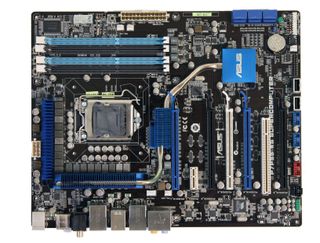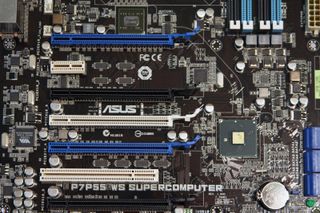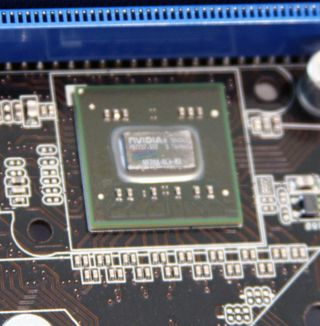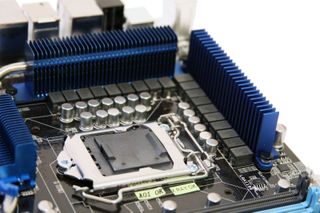Asus P7P55 WS Supercomputer P55 Motherboard Preview
Just Another P55 Board...Or Not?

Meet Asus' P7P55 WS Supercomputer, little brother to the P6T7 WS Supercomputer based on Intel's X58 chipset. Of course, the P7P55 WS centers on P55, Intel's upcoming platform controller hub, complementing LGA 1156 Core i5 and Core i7 processors.
From over top, everything about the P7P55 WS looks fairly standard, but there's actually quite a bit going on with this platform when you zoom in and start flying by its various onboard components. For instance, notice the five PCI Express x16 slots. So what, right? The P6T6 WS Revolution sports six PCI Express x16 slots, after all.
Ah, but the rabbit hole goes deeper. Remember, there's a world of difference between the X58 and P55 chipsets...
In case you've missed any of our other P55 motherboard previews, we covered Gigabyte's microATX P55M-UD4 and Asus' P7P55D Deluxe in the same picture story. We introduced Gigabyte's P55-UD4P and P55-UD6 in another piece. Before that, Asus' P7P55D Evo stood on its own. Don't worry, we're looking to share the love. Solutions from MSI and ASRock are up on the block next.
Bare Naked Motherboard

As you saw on the previous page, Asus ships the P7P55 WS Supercomputer with a passive heatpipe snaking its way from the voltage regulation circuitry down to the P55 PCH. Well, we've seen a number of boards already employing similar layout cues with ineffective cooling elements at different points in the chain. Not so here; each cooling component serves an actual purpose.
Naturally, because the P7P55 WS is a more involved product, we wanted to pop the board's cooling off to check underneath. The above shot shows Nvidia's NF200 PCI Express bridge, five PCI Express x16 slots, one PCI Express x1 slot, and one standard PCI slot. To the right you see the P55 PCH. That's a ton of PCI Express connectivity, right? Where the heck does it all come from?
Now There's A Familiar Face

Seen most recently in our performance exploration of MSI's X58 Eclipse Plus motherboard, Nvidia's NF200 PCI Express bridge chip is necessary on a platform like this one, with its sixteen lanes of integrated PCI Express 2.0 connectivity.
Stay on the Cutting Edge
Join the experts who read Tom's Hardware for the inside track on enthusiast PC tech news — and have for over 25 years. We'll send breaking news and in-depth reviews of CPUs, GPUs, AI, maker hardware and more straight to your inbox.
Here's where the story gets a little crazy. X58 provides up to 36 lanes of PCIe 2.0, making it relatively easy to serve up four x8 links or, as we saw in the MSI story, mux lanes to deliver a trio of true x16 links (masking the fact that two x16 links actually share one x16 link from the host). So, with that many lanes available, building boards with six x16 slots makes sense. It's a niche proposition, sure, but for for the workstation users banking heavily on Nvidia's CUDA technology and running several Tesla cards in parallel, we see the allure.
So how does Asus do it with P55, which does sport eight of its own PCI Express 2.0 lanes, but connects to its Core i7 or Core i5 through a DMI interface? Granted, this generation of DMI could be as fast as 4 GB/s, since P55 includes PCIe 2.0 data rates. But even then, that's the equivalent of a x4 slot shared between peripherals attached to the PCH.
Enter NF200. The bridge takes the processor's 16 lanes and turns them into 32, enabling 16/8/8 configurations from a platform supposedly limited to one x16 slot or two x8s. Presumably, the other two slots support up to four lanes each and attach to the P55 PCH, but we're still waiting to hear back from Asus regarding the effect of populating all five x16 slots, and what that'd do to the two RTL8112L GigE controllers onboard.
Update: Asus just stopped by our Culver City office with a board diagram. Four PCIe x16 links actually attach to the NF200, switching to 8/8/8/8 when four cards are installed. The fifth card attaches to P55 and gets four lanes of PCIe 2.0 connectivity. Naturally, those aren't configurations you'd want for a four-way CrossFire setup or anything; according to Asus, this board is strictly for workstation-based applications.
Of course, there are performance implications to splitting 16 lanes between three high-end graphics cards, but we'll have to wait until after P55's official launch before we can start talking about them. For the time being, we're left impressed that Asus' engineers were able to use NF200 to enable a capability otherwise unavailable from P55. The bridge chip might not have been necessary for X58-based gaming machines, but it may very well prove useful to enthusiasts looking to build an inexpensive Core i5 box and put extra money into graphics. There's also the professional crowd, which can use the expansive PCIe connectivity with Nvidia's hardware/software technologies to accelerate engineering and science applications.
Five Slots Of Fury

The P7P55 WS Supercomputer sports five PCI Express x16 slots, as mentioned. Slots 1, 3, and 5 are the three connected to the Core i5/i7, leaving two slots worth of room between each (and incidentally ensuring compatibility with dual-slot cards, without one hanging off the bottom of the board).
The remaining two x16 and x1 slots rely on P55's available bandwidth. Naturally, there's a lot of sharing going on there, as well. Preliminary chipset diagrams suggest one runs at x8 signaling rates, automatically split into x4/x4 when another card is installed (though that still doesn't address the onboard networking).
Update: As mentioned on the previous page, four slots are actually connected to the NF200 bridge: the two black and two blue slots, each offering eight lanes of PCI Express 2.0, if they're all populated. Of course, given that they're actually communicating over Core i5/i7's 16-lane link, this wouldn't be an idea gaming graphics setup. The last x16 slot gets four lanes from Intel's P55 PCH, leaving enough PCIe for the x1 slot and both Gigabit Ethernet controllers.
Rear-Panel I/O

If the board looks a bit flexed, that's because it is. But bear in mind that this is a pre-production sample, and once you get it onto a motherboard tray, it sits flat.
The P7P55 WS Supercomputer's rear I/O panel reflects fairly standard connectivity. You'll find a pair of PS/2 ports, eight USB 2.0 ports, twin Gigabit Ethernet jacks, optical/coaxial digital audio output, and six 1/8" mini-jacks for analog audio I/O.
It's also worth noting that Asus bundles what it calls a G.P. Diagnosis card, which plugs into the P7P55 WS' TPM header and provides a two-digit LED readout, plus power and reset buttons.
A Few Features We've Seen

Asus is standardizing its Q-DIMM slot design across the P55 family. We've already had the chance to use this on two other Asus boards and have to say it's much more convenient than pulling a graphics card every time we need to swap memory.
The P7P55 WS Supercomputer also includes several other features seen in our past previews. TurboV Evo, for instance, is Asus' hardware-based overclocking solution, which allows you to alter BIOS settings through the company's custom Windows-based software. The T.Probe feature monitors temperature and loading of the board's power phases and adjusts in an effort to balance thermals across the voltage regulation circuitry. MemOK!, which we've been testing on the P7P55D Deluxe, sets failsafe presets on modules experiencing compatibility issues for one reason or another. And of course, Asus integrates its EPU, which throttles back power consumption on a system level during periods of light load.
16+3 Phase Power

As with its more mainstream P55-based boards, Asus uses passive cooling on the voltage regulation circuitry, NF200 bridge chip, and P55 platform controller hub. Here we see the chokes and capacitors related the P7P55 WS' 16 (CPU) + 3 (memory) implementation.
Keeping SATA Simple

We've seen plenty of chatter about the possibility of 6 Gb/s SATA making it onto a number of P55-based motherboards at launch (and indeed, it's looking like at least one vendor will be integrating the feature in its retail package via expansion card). That doesn't matter here, though, as the P7P55 WS Supercomputer either gets by with its six onboard 3 Gb/s SATA ports or takes advantage of Asus' special SASsaby controllers, 3 Gb/s SAS cards optimized for the company's WS-series boards.
Of course, if you wanted to go even more modern, you could drop one of LSI's new 6 Gb/s SAS cards into the platform.
-
apache_lives so asus stole "supercomputer" from asrocks "X58 SuperComputer" motherboard, and wtf is with that name, it isnt a supercomputer - a "super" computer would bring me a coffee and massage my back while i work.Reply -
one-shot I'm still not regretting getting a 1366 socket i7 rather than waiting for the 1156 socket "i7". These new chips appear to be solid, but my needs require a faster CPU. It'll be interesting to see how AMD reacts after launch.Reply -
JeanLuc Spelling error - page 3, paragraph 2, line 3 "as we saw in the MSI story, muxlanes"Reply
Good to see that there's a Nvidia's NF200 PCI Express bridge chip is included. Does that mean we will be able to run two video in crossfire/SLI at 16/16 or will the board always be limited to only 8x on the second lane? -
idisarmu onlyojayi know this will be like just a wet dream but...4870x2 x 5?Reply
If that were possible... it would still be stupid.
Why would you do that if you could put 5 gtx295s in there? (though that's impossible too) -
Shadow703793 apache_livesso asus stole "supercomputer" from asrocks "X58 SuperComputer" motherboard, and wtf is with that name, it isnt a supercomputer - a "super" computer would bring me a coffee and massage my back while i work.ASRock was part of ASUS.Reply -
theholylancer i thought asrock is still part of asus, except they are now allowed to make premium boards.Reply
Most Popular




